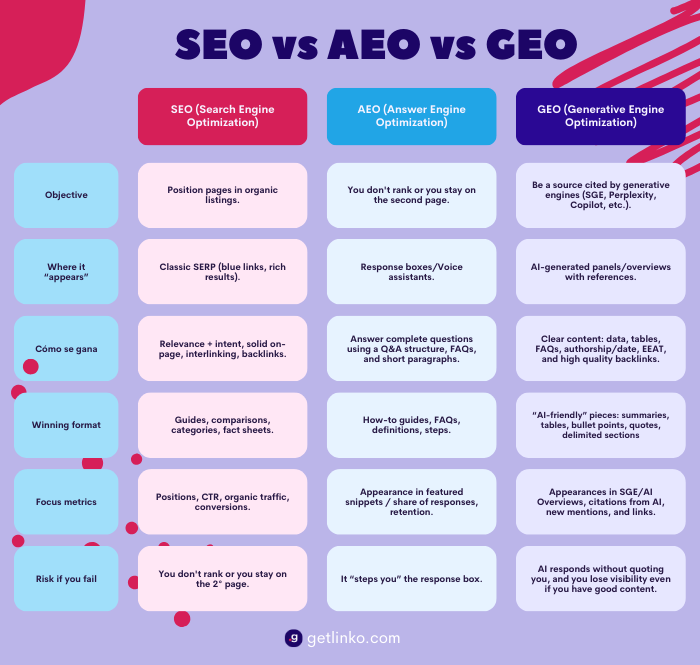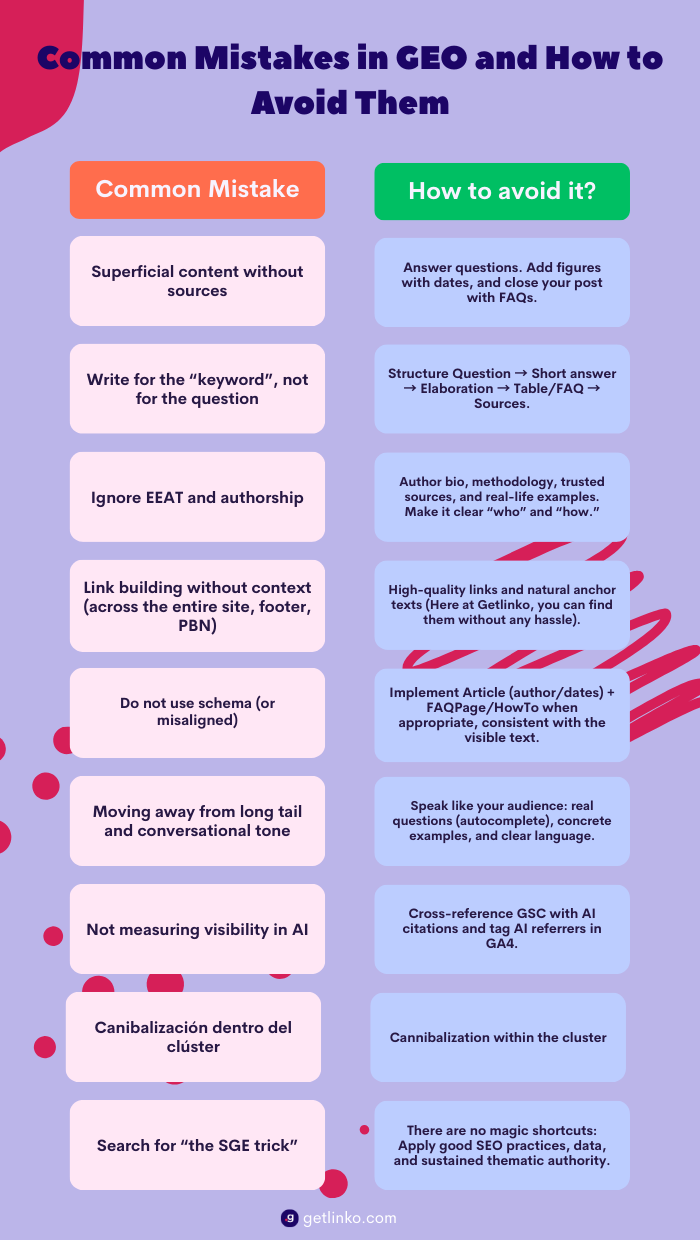What is GEO?
Generative Engine Optimization (GEO) is about getting AI to cite you as a source when it builds answers. You get there with clear, checkable content — question→answer, tables/FAQs, data with references — plus authority signals that back up your site. Put: write so generative engines trust you.
SEO vs AEO vs GEO
To keep the big picture simple: SEO aims to rank, AEO aims to be the answer, and GEO aims to be the cited source in AI results. The table below summarizes where you appear, how each field is won, which formats work best, and which metrics to watch, so you can pull the right lever for each content type.
When to use each one (in practice)
- SEO: ongoing foundation to capture steady demand and business pages.
- AEO: clusters of specific questions (FAQs/how-to) and informational long tail.
- GEO: strategic pieces with data and sources; ideal for topics where SGE/AI already shows summaries and you want to be cited.
Why GEO matters now?
GEO matters because it helps you become the source AI chooses when it summarizes; without that, your visibility and qualified traffic take a hit. At the end of the day, the ranking game changed, and you want to be where AI engines look (and cite). A few datapoints worth keeping in mind:
- AI summaries already show up often and are growing: recent studies place them in ~11% to 30% of searches (and up to 74% in “how to solve…” queries, where it hurts most).
- When an AI Overview appears, clicks drop: people click fewer links; several analyses point to declines of around 30–35%. If you’re not cited, you fade into the background even with strong content.
- You can “sneak in” without being top-10: a meaningful share of links AI shows doesn’t come from the top organic results. Pure opportunity for brands that deliver clear, verifiable data.
- Coverage is expanding by market and query type (e.g., the UK ~18% in 2025; it rises over time and by vertical). Optimizing for GEO gets you ready for that expansion.
- Discovery channels (Perplexity, ChatGPT, Copilot, AI Overviews) run on citations: if your content is understandable, structured, and sourced, you’ve got a real shot at showing up as a reference.
How do “generative engines” work?
They all follow a similar playbook: understand your question, fan out into several related vertical searches to cover subtopics, read a handful of pages, summarize with an AI model, and return an answer with supporting links (product-dependent). Google spells it out: its AI “fan-out” modes search subtopics and show a more diverse set of links than classic search.
Google: AI Overviews and AI Mode
They show an AI-generated summary with “links to dig deeper.” They fire when the system detects they add extra value over classic search.
AI Mode is designed for more complex questions (comparisons, reasoning) and, like Overviews, uses fan-out to find more sources and offer more and better links.
Bing / Copilot Search
Returns summaries with citations to sources; Microsoft positions it as “complete, cited answers” on top of the Bing index.
Perplexity
Answers with numbered citations and links to the original pages by default. In its Deep Research mode, it runs dozens of searches, reads hundreds of sources, and synthesizes a report.
ChatGPT
When it searches the web, it shows answers with clear, relevant sources (first announced as SearchGPT and later as “ChatGPT search”). The idea: up-to-date answers with online citations and a side panel of links.
What usually works to show up in GEO searches?
Generative engines don’t just “read and summarize”; they also display (with nuances) the sources they consulted, and while there’s no single official checklist, what teams themselves share suggests it helps to have:
- Clarity and structure (Q→A, lists, tables), correct indexing, and structured data aligned with the on-page text.
- Verifiable and varied sources: systems aim to show a diverse set of supporting links.
- Context and authority: visible authorship, trustworthy pages, domain reputation, and topical consistency. Here’s the kicker: strong link building with quality links placed within well-contextualized content from reputable publications. Relevant links (same topic), natural anchors, and placement in editorial body — not filler zones — are the ones that truly move the needle for GEO.
GEO strategies that work
Editorial clarity and structure
Objective: help AI grasp your piece at a glance so it can use it without losing the thread.
How to apply it:
- Structure each article into question → short answer → development → table/FAQ → sources.
- Use H2/H3 with intent (“what is…,” “how to…,” “examples,” “common mistakes”).
- Short paragraphs (2–3 lines), bullets, and tables for concepts/comparisons.
- Add a TL;DR at the very top with 3–5 bullets.
Example: “What is Generative Engine Optimization?” → 2-line definition + SEO vs AEO vs GEO table + 2 sources.
Citations, references, and verifiable data
Objective: make yourself cite-able — easy to verify and trustworthy.
How to apply it:
- Include 2–3 references (ideally primary sources or studies).
- Give dates, figures, and methodology (where the data comes from).
- Use screenshots/tables with clear metrics; link to the origin.
- Add a visible “Last updated” timestamp at the top.
Example: “38% of…” + link to the original study + one line of context (sample, period, country).
E-E-A-T and topical authority
Objective: prove real-world experience and reputation on the topic.
How to apply it:
- Visible author with bio (expertise, role, LinkedIn), editorial policies, and trust pages (About, Contact, Methodology).
- Cluster interlinking: a hub guide + spoke articles for each subtopic.
- And here’s the secret sauce: quality link building within well-contextualized content from reputable outlets.
- No orphan links: the anchor and the paragraph around it should speak to the topic.
- Back it up with external mentions (interviews, podcasts, proprietary studies).
Example: your own case/study referenced by a sector publication that reviews your methodology.
“AI-friendly” format (markup and FAQs)
Objective: make your content machine-readable without overcomplicating things.
How to apply it:
- Add schema: Article (author, date), FAQPage (direct questions), HowTo (steps), Product (if applicable).
- Wrap each section with short FAQs (2–4 “user-type” questions).
- Use numbered lists for processes and tables for decisions.
- Declare units, definitions, and criteria (avoid ambiguity).
Example: “Steps to implement GEO” in 5 numbered items + FAQ “Does GEO replace SEO?”
Long tail and conversational language
Objective: capture real questions as people actually phrase them.
How to apply it:
- Lead with full questions in titles and headers (“How do I measure GEO without losing sight of SEO?”).
- Work long-tail and natural synonyms into the text (without forcing it).
- Answer in a human tone: concrete examples, mini-cases, “watch out for…”
- Draw inspiration from People Also Ask, autocompletes, and related searches.
Example: “Is GEO link building worth it if I’m not top-10?” → short answer, example, and what to do before you apply it.
Ongoing updates
Objective: keep things fresh and avoid your piece going stale for AI.
How to apply it:
- Refresh calendar (e.g., quarterly for dynamic topics).
- Review outdated data, screenshots, and links; add a “What changed” section.
- Keep a changelog and show “Last updated” at the start.
- Avoid cannibalization: if a new piece replaces another, redirect.
Example: every 90 days, audit 10 key URLs: update figures, add 1–2 new sources, and one more FAQ.
Content architecture for GEO (hub & spoke)
The idea is to build a cluster where a central guide (the hub) explains the topic end-to-end, and several satellite pieces (the spokes) answer specific questions that generative engines tend to “split up” via fan-out. That way, your site stays organized, easy to understand, and citeable.
Cluster objective
- Be the canonical reference on Generative Engine Optimization.
- Cover subtopics and real questions in short, very clear pieces.
- Make it easy for AI to find, verify, and cite your answers.
- Reinforce authority with internal linking and contextual link building (here’s the sauce: quality links within contextual content from trustworthy outlets).
Simple internal linking rules
- HUB ↔ SPOKES: each spoke links to the HUB in the intro, and the HUB links to all spokes from a visible index.
- SPOKE ↔ SPOKE: link “siblings” when it makes sense (e.g., from Strategies to Long tail).
- Depth ≤ 3 clicks: the entire cluster should be at most three clicks from the homepage.
Extras that boost citability
- GEO glossary: entities and short definitions.
- Own cases and data: mini-studies or benchmarks act like link magnets.
Measuring GEO (beyond traffic)
he point of Generative Engine Optimization isn’t to “move up positions,” it’s to appear and be cited in AI answers. Measure that, not just sessions.
Visibility in AI experiences
Before visits, check whether you appear in AI experiences (AI Overviews/AI Mode, Copilot, Perplexity). Track the trend in Search Console and cross-check with Ahrefs’ AI citations and Semrush tracking to see where you’re cited and which URLs get the credit. If you’re mentioned frequently, you’re on the right track.
How do I track my mentions in AI?
With Ahrefs’ AI citations, you can see where assistants (ChatGPT, Gemini, Copilot, Perplexity) cite you and analyze overlap with organic rankings. They also publish helpful studies for context, like overlap between AI citations and the top 10.
Semrush, for its part, offers Position Tracking and Sensor so you can monitor AI Overviews and their volatility; and with Enterprise AIO you can see AI-level visibility metrics at the prompt level.
Common mistakes (and how to avoid them)
Close the loop and put Generative Engine Optimization to work now: pick your key pages, give them an AI-friendly structure, and add authority signals with real editorial links. The no-brainer route? Getlinko: it helps you land authority links in reputable outlets with editorial context — exactly what you need to strengthen your E-E-A-T and show up in GEO and AI Overviews where people actually look.












